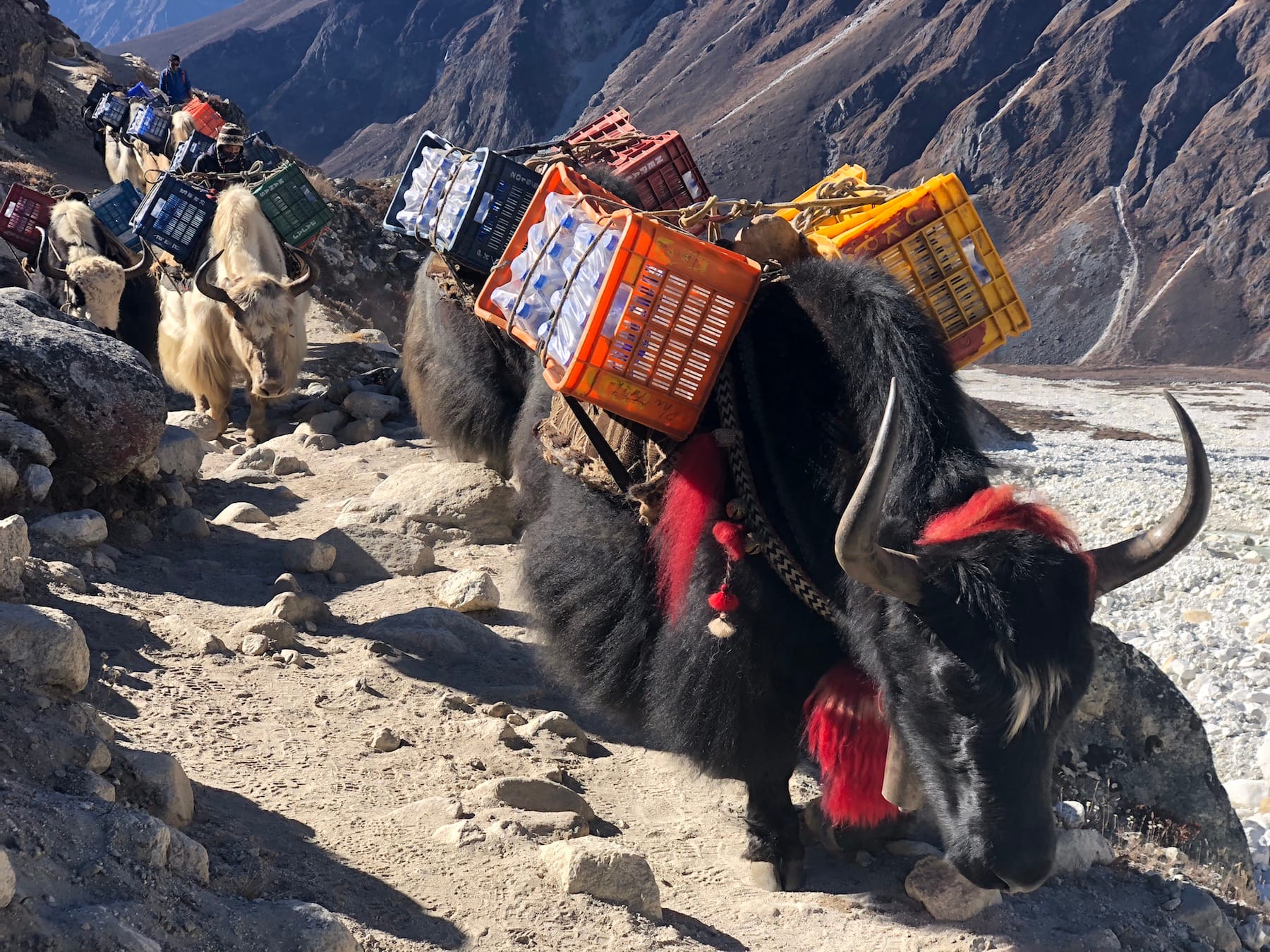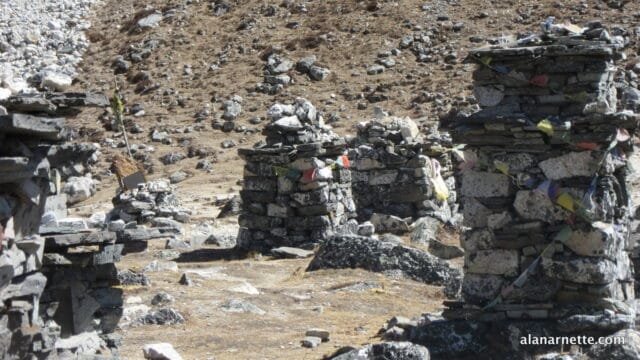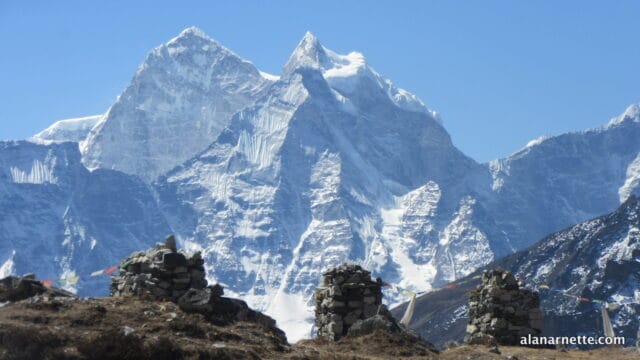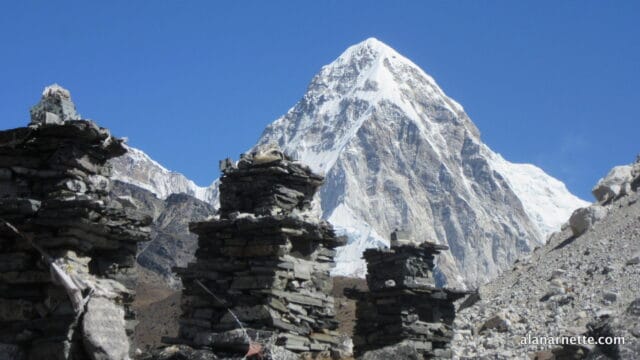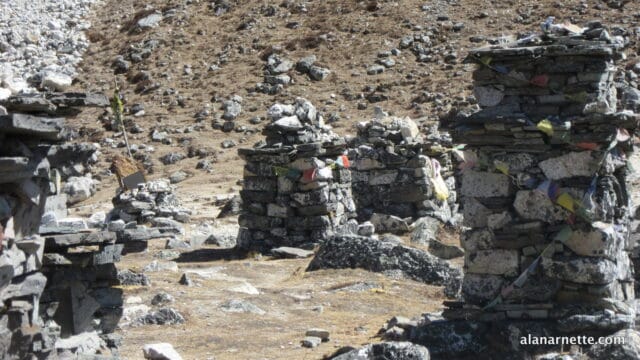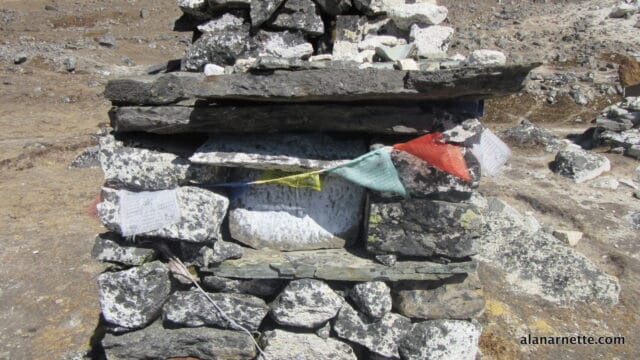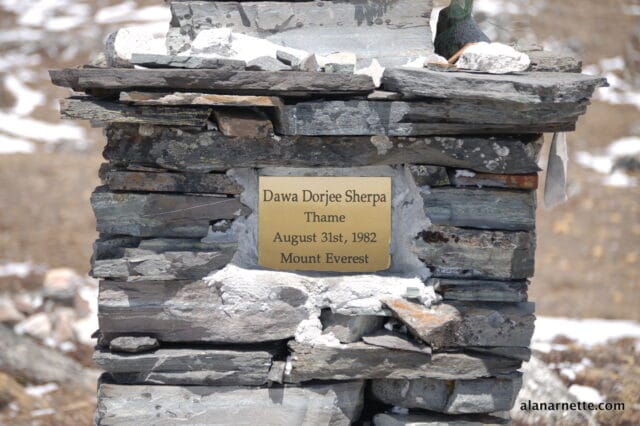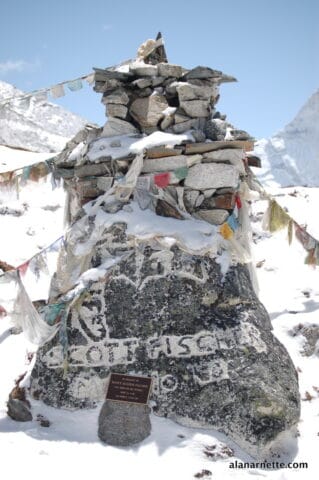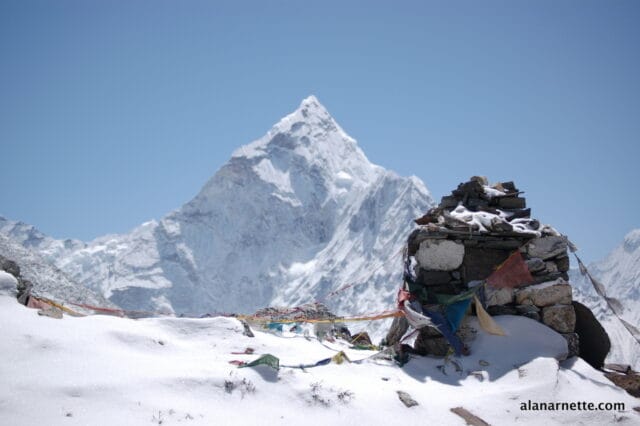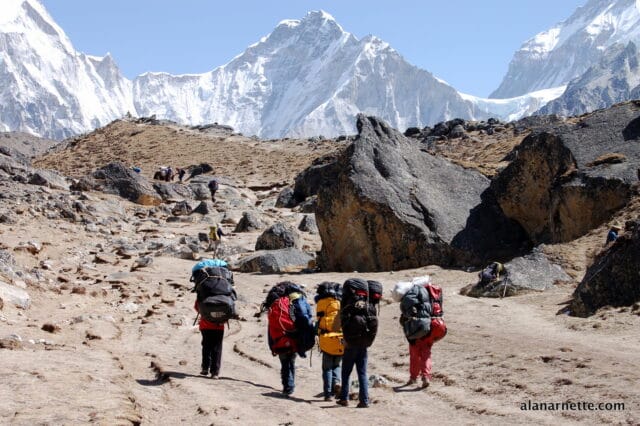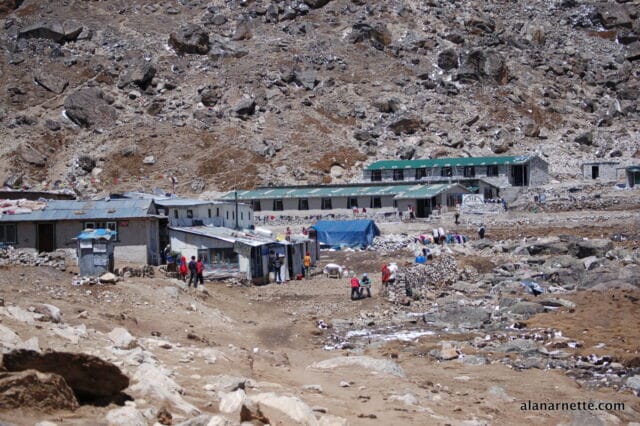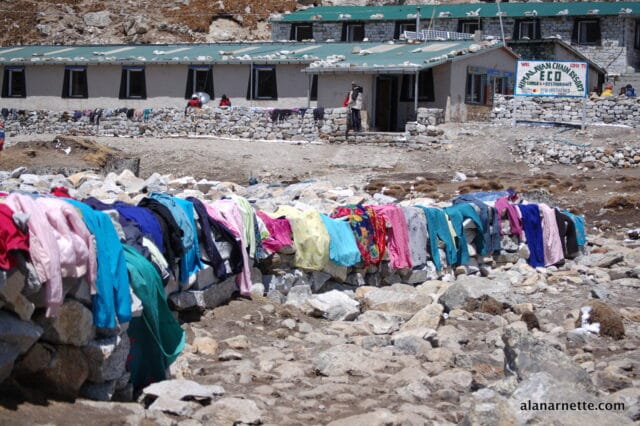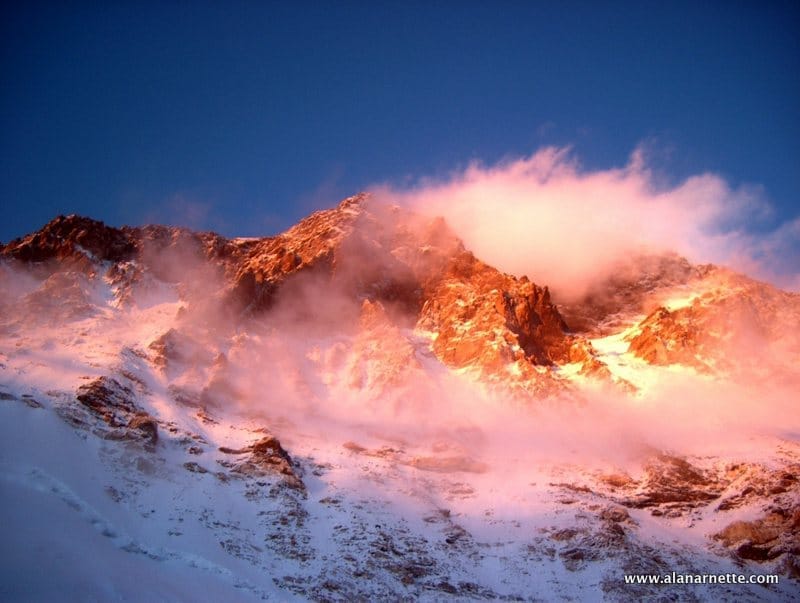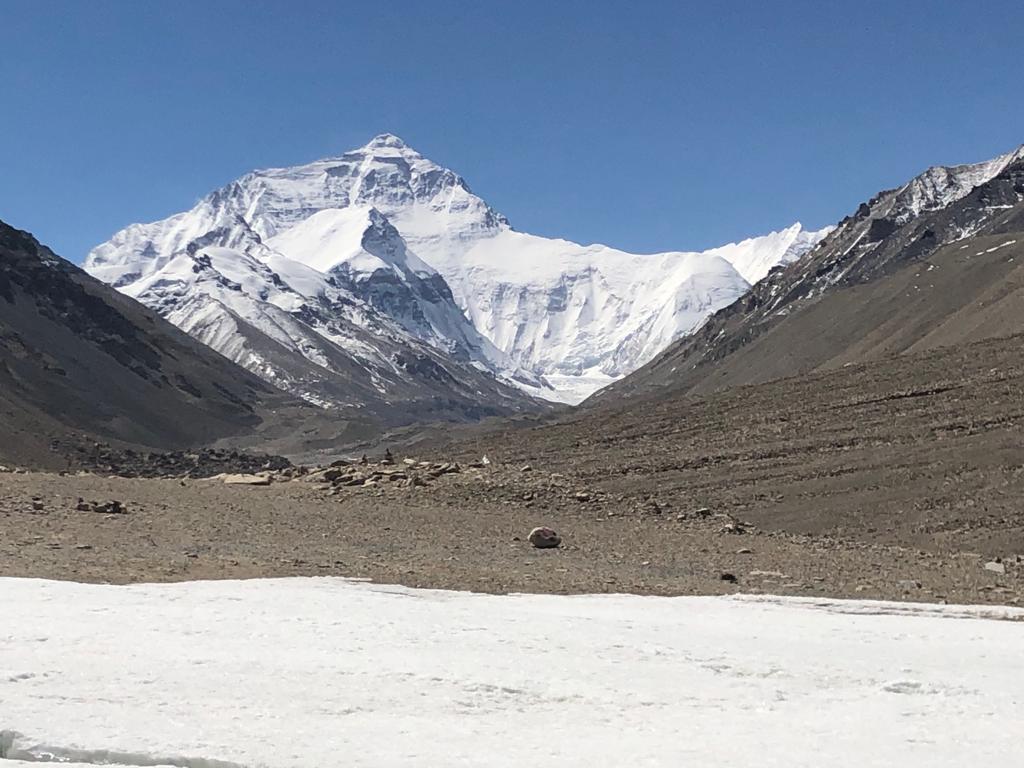It’s a huge day at Everest Base Camp on the Nepal side, aka EBC–the first commercial team has arrived! This is almost a week earlier than in 2023. It will be their home until late May unless they are on acclimatization rotation and, of course, the summit bid. The majority of Everest summits occur between May 18th and 23rd. However, the Icefall Docs still have problems in the upper Icefall. Thankfully, most teams are still on their trek, so there’s no problem, yet.
On the Tibet side, Adventure Peaks reports, “It looks like the border might not open until the 17th April, so the team are planning to head to Langtang in order to start acclimatising.”
The Everest Nepal permit tally now has 149 foreigners across 13 teams. Tibet does not report permit updates.
International Mountain Guides is traditionally one of the first commercial teams to arrive at EBC, and they didn’t disappoint in 2024. IMG gave this update:
Ang Jangbu reports that Team 1 departed Lobuche Base Camp (about 15,500 ft) and had a nice hike today up to Everest Base Camp (about 17,500 ft), arriving before 2pm. They were greeted by cooks Kaji and Nima and the BC team, who have been working hard to get the camp all buffed for their arrival! Three days behind, Phunuru and Team 2 moved from Pheriche up to Lobuche Base Camp and are also doing well, arriving in good time.
The report from higher up on the mountain is that the Khumbu Icefall Doctors have been working hard on the Icefall route, but have run into some difficulties above the Football Field, requiring some route modifications. They have not yet reached Camp 1 and will need some additional time before the route gets opened.
Leaving Grass
The late Anatoli Bourkreev coined the phrase “touch grass before the summit,” meaning that he descended from EBC to the nearest village that had grass in the area, say Tengboche, before returning for his summit bid. He felt it helped his body recover from weeks at extreme altitude and gave him a rest. Today, our climbers are leaving any grass for the tundra of the high Himalayas. Let’s follow them as they go higher, and for the trekkers, they reach their summit–Kala Partar.
 Now, the altitude is getting serious. After your “active rest day” at 4,420 meters/14,500 feet in the village of Dingboche, it’s time to move even higher.
Now, the altitude is getting serious. After your “active rest day” at 4,420 meters/14,500 feet in the village of Dingboche, it’s time to move even higher.
The routine is familiar and even routine. Wake up as the sun rises, and throw more layers on top of the layers you slept in. Comb your hair, or just put the skull cap on tighter. Wash your face and brush your feet. Re-pack your sleeping bag for the 785th time this trip and haul your bag into the hall for the porter to carry. Stuff a few things in your day pack, which has gotten amazingly small as your duffle bag has grown amazingly large since you left Kathmandu. You go to breakfast. All of this takes 17 minutes – you timed it.
Leaving Dingboche, you re-climb a steep hill to the ridge you hiked up yesterday to 5,181 meters/17,000 feet on your “rest” day! It was tough, but the views were amazing. You finally understand the work/reward equation of trekking in the Himalayas. Today’s objective is another high-altitude village, Lobuche, at 4,940 meters/16,207 feet
The terrain is very different than the land of rhododendrons and magnolia trees. This alpine land is fragile, yet an obvious trail marks the route based on hundreds of thousands, if not millions, of footsteps. It takes a moment to destroy it and a decade or century to grow back in this environment.
Every turn seems to bring another astonishing view, and you thought Ama Dablam was perfect. It just gets better and better.
The route goes downhill and follows a stream until the stream becomes a river with large rocks on both banks. A makeshift bridge is in place; it seems all the previous models have washed away. You watch a few kids run across the bridge with the ease of a galloping horse–no hesitation, only confidence and giggles. But you move gingerly across the bridge and follow the dirt path up a small hillside.



You have become accustomed to the yak trains that are everywhere now. Even though they are familiar, you always stop and take their picture—they don’t seem to mind, and you can never have enough Yak pictures! Their clanging bells are now a source of comfort. You step aside on the uphill side! You don’t want to be pushed down the steep hill and into the freezing river by an oblivious bovine!
They saunter by with the ease of a sleeping frog. Their dark eyes fixated on their next step, their long, neatly groomed tails swishing in the cool alpine air. You take another picture. Then put the camera away and just watch as they pass, one by one by one.
Soon, their guardian goes by, “Namaste!” you say with a slight mumble and embarrassment, trying to fit into a surrounding you had only read about. She looks up. A small, warm smile develops. Her dark, shiny hair glistens in the bright daylight. “Namaste.” she rewards you. You smile and feel warm inside.

Just beyond the bridge is the hamlet of Dugla, 4,620 meters (15,160 ft), with only a few simple huts and buildings. One serves as a restaurant that is brimming with trekkers, climbers, Sherpas, porters and locals. It seems everyone has the same meal, fired rice. You spice things up with an Orange Fanta (not diet), something you would never eat and drink at home but burning 6,000 calories a day has its benefits!
Lunch is easy and relaxed. You are adjusting to Sherpa time. “No hurry, chicken curry.” you remember Kami telling you from a previous climb. You chuckle at the memory.
As you move to a chair outside, a polite woman takes your plate away. Closing your eyes, you let the sun warm your face, but the chill remains. Soon, it’s time to leave. Grabbing your day pack, you start up the steep dirt hillside, following the other climbers, trekkers, yaks, and Dzos on their journey. Topping the hill, the mood changes. All you see are memorials.
The Fallen
Even though Lobuche is not far away, you stop. You take off your pack and pull your jacket tighter around your neck. The wind has picked up at Dugla Pass, but it does not matter.

A long ridge holds fifty or more chortens or rock memorials. Each one has a name carved in the stone or perhaps a more elegant brass plaque. The vast majority are for Sherpas who have died helping Westerners achieve their goals.
You stop at each one. How did they die? Weather, health, accident? It did not matter.
There were climbers from many countries: Belarus, Japan, Austria, Canada, Nepal. Most were Sherpa. Most were young. Climbers following their passion. Chasing their dream. Doing a job. It did not matter.
Most of the names have been eroded away leaving you to only see the remains of name or a date. Some were famous – Scott Fischer, Babu Chiri. Most were not familiar. Names long since forgotten by the climbing community. Names remembered daily by their families.
The setting was perfect – above the treeline – on the alpine tundra – views of mountains. They would have liked it.
But you had something else to do. The email read in part, “can you see if his memorial is still there?” The trek to Base Camp takes you through 30 or more stone memorials but this was different. Row after row of chortons. You lose count. So many have died. The email was from the 80-year-old father of such a climber.
You take off your pack and start the search. You stop at each one. You read the inscriptions, some barely visible, worn away from decades of wind, snow and sun. You walk each row slowly and respectfully. You know that each one has someone wondering if their remembrance for their loved one was still there. You stop at one, an old one, almost falling over. Your ungloved index finger gently traces the characters in the stone. You move on. I’m sorry, Sir. I never found Greg’s memorial. But I know his memory lives on in you.
Leaving the area, you walk a bit slower, thinking about the team and Sherpas who will be there, your purpose, your home, and the task ahead. It is now clearer than ever that climbing Everest is deadly serious. You glance at your Sherpas with respect and appreciation, understanding that, for most, it is their job to help you achieve your dream.
It was an emotional day seeing the Chortens for those who died on Everest as you trek to Lobuche at 4,940 meters/16,207 feet. When you arrived at your teahouse, you had a quiet dinner and went to bed early. You didn’t feel like the usual flirting and gab that came with dinner.
Gorak Shep
Today, you’re trekking to the last village before Everest Base Camp, Gorak Shep. Located at the edge of a frozen lake at 5,164 meters/16,942 feet, it serves as a host to Kala Patar. You manage to get permission for one more photo of a child of the Khumbu, and you’re glad you did.
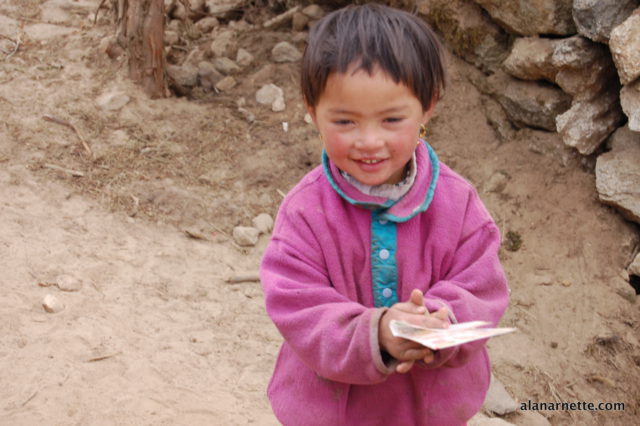
As you left Lobuche, the trail was well-behaved and smooth, with no drastic ups and downs. You thought, I finally have this under control … until. As you approached Gorak Shep, the trail lost its mind! It climbed steep rocky hills and then back down—back up again—what the ..? Then you remembered where you were, and all was right with the world.
Relax. Breathe. Peace. Kindness. More yaks.
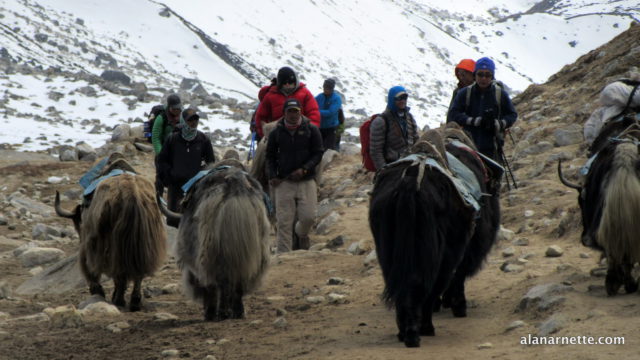
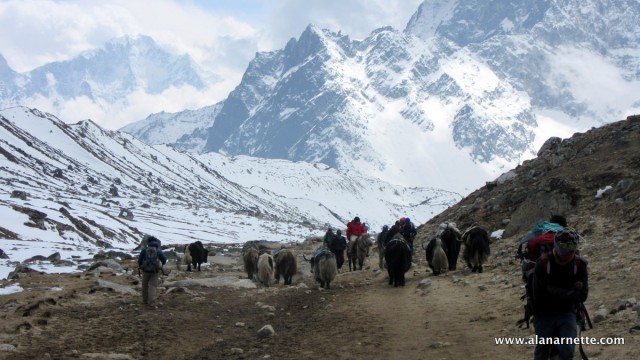
You began to see the long melted remnants of the Khumbu Glacier when it was miles longer than today. The high dirt walls with rocks at the top is the hint that a glacier once carved its way through this area.
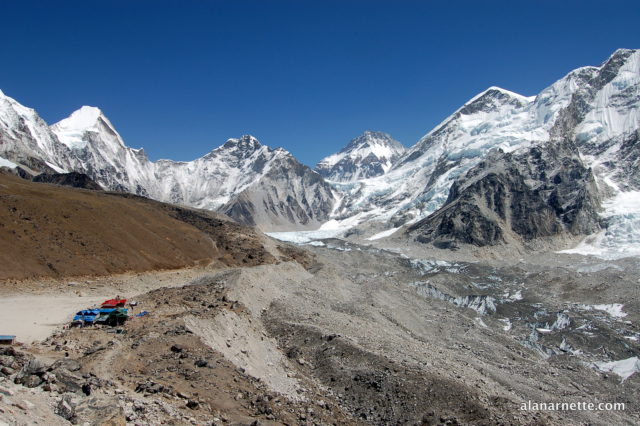
You arrive at Kala Patar with Pumori standing proud in the background.
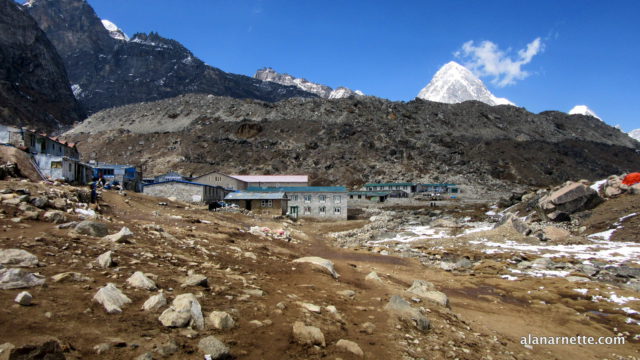
Kala Patar
For many trekkers to EBC, KP is their summit. Almost an inconsequential hill in the context of the Himalayas, KP offers an amazing view of Everest, especially at dawn or sunset. It is 5,550 meters/18,209 feet and has an unobstructed view.
You leave the teahouse for the summit, knowing it is supposed to be cold and windy on top, so you dress and pack accordingly. It is only 386 meters/1,267 feet from your teahouse to the summit, so how hard can this be? After all, you went to 17,000 a couple of days ago … Ok, it was hard then.
You and your team cross the frozen, dried-out dirt lake bed, which you really didn’t notice, and begin the gradual climb. You were told it should be a four-hour round-trip journey. Hmm, after half an hour, you are questioning many things—their estimate, your fitness, and your judgment. But you continue.
The trail is well worn, as all have been in the Khumbu. You rarely look at anything other than your feet, exactly one meter or three feet ahead. When you do look up, the view is amazing, but …
Higher and higher … the wind picks up. You add an extra layer and pull on your secondary gloves. Yes, perhaps the Buff would be good now. Your breathing increases. You slow down. Another step and another. A Sherpa that is climbing with you runs by to check on a team member.. “runs by” … Oh my. A group is coming down, so you politely step aside to let them by. It is a total ruse, as this is an excuse for you to stop and BREATH!!
And then you are there – your summit – Kala Patar.
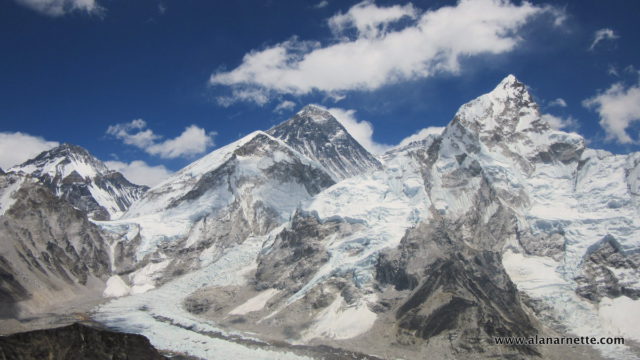
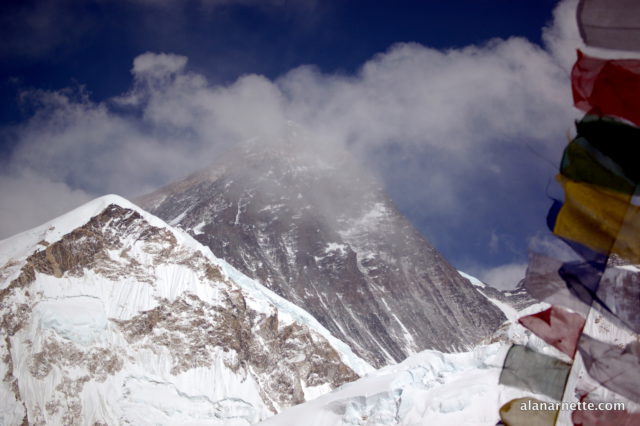
As you lift your head up from your knees, you gasp a huge breath and look into the horizon. There it is–Everest. Your eyes trace the skyline–where the edge of the mountain meets the sky. Starting as low as you can, you follow it up, higher and higher, until there is no more mountain edge, only sky. You blink and rub the water from your eyes. The cold air is causing you to tear up, or maybe it’s from something else.
This is now your third or fourth view, but this one is different. The plume is real. It’s huge. You can see the South Summit, the Hillary Step, and the North side. You are seeing Everest like you have always dreamed and hoped.
And it’s windy!
For trekkers, this summit view will last a lifetime. For climbers, it’s a taste of what’s to come.
No matter, it’s the view of views, and you made it.
Climb On!
Alan
Memories are Everything
The Podcast on alanarnette.com
You can listen to #everest2024 podcasts on Spotify, Apple Podcast, Breaker, Google Podcasts, Pocket Casts, RadioPublic, Anchor, and more. Just search for “alan arnette” on your favorite podcast platform.
Preparing for Everest is more than Training
If you dream of climbing mountains but are unsure how to start or reach your next level, from a Colorado 14er to Rainier, Everest, or even K2, we can help. Summit Coach is a consulting service that helps aspiring climbers worldwide achieve their goals through a personalized set of consulting services based on Alan Arnette’s 30 years of high-altitude mountain experience and 30 years as a business executive. Please see our prices and services on the Summit Coach website.
Everest Season Special through May 31, 2024: 10% discount on all plans. Mention Everest 2024.

